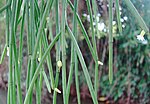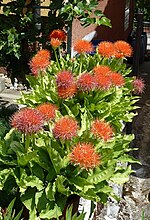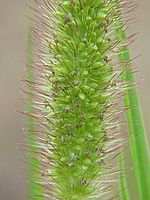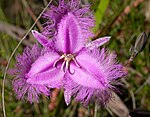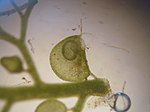| Genus
|
Meaning or derivation
|
Family
|
Order
|
Ref
|
G
|
| Quercus
|
Latin name
|
Fagaceae |
Fagales
|
CS |
G
|
| Quillaja
|
Chilean name
|
Quillajaceae |
Fabales
|
St |
G
|
| Ranunculus
|
Latin: little frog (some species are aquatic)
|
Ranunculaceae |
Ranunculales
|
CS |
G
|
| Raphanus
|
Greek and Latin name
|
Brassicaceae |
Brassicales
|
CS |
G
|
| Raphia
|
needle (the fruit)
|
Arecaceae |
Arecales
|
St |
G
|
| Ravenala
|
Malagasy name
|
Strelitziaceae |
Zingiberales
|
St |
G
|
| Renanthera
|
kidney anther (the kidney-shaped pollen-masses)
|
Orchidaceae |
Asparagales
|
St |
|
| Reseda
|
Latin name
|
Resedaceae |
Brassicales
|
St |
G
|
| Restio
|
Latin: rope-maker
|
Restionaceae |
Poales
|
Ba |
G
|
| Retama
|
Arabic name
|
Fabaceae |
Fabales
|
St |
G
|
| Rhabdothamnus
|
rod (twiggy) bush
|
Gesneriaceae |
Lamiales
|
St |
G
|
| Rhamnus
|
Greek and Latin name
|
Rhamnaceae |
Rosales
|
CS |
G
|
| Rhaphidophora
|
needle-bearing (the fruit)
|
Araceae |
Alismatales
|
St |
G
|
| Rhaphiolepis
|
needle scale (the bracteoles). Previously Raphiolepis.
|
Rosaceae |
Rosales
|
CS |
G
|
| Rhaphithamnus
|
needle bush (the spines)
|
Verbenaceae |
Lamiales
|
St |
G
|
| Rhapidophyllum
|
needle leaf (the spines at the base)
|
Arecaceae |
Arecales
|
St |
|
| Rhapis
|
needle (the leaf segments)
|
Arecaceae |
Arecales
|
CS |
G
|
| Rheum
|
Greek name
|
Polygonaceae |
Caryophyllales
|
CS |
G
|
| Rhexia
|
Latin name
|
Melastomataceae |
Myrtales
|
St |
G
|
| Rhinanthus
|
nose flowers
|
Orobanchaceae |
Lamiales
|
Ba |
G
|
| Rhipsalis
|
wicker
|
Cactaceae |
Caryophyllales
|
St |
G
|
| Rhodanthe
|
rose-red flowers
|
Asteraceae |
Asterales
|
Ba |
G
|
| Rhodanthemum
|
rose-red flowers
|
Asteraceae |
Asterales
|
Ba |
G
|
| Rhodiola
|
little rose
|
Crassulaceae |
Saxifragales
|
CS |
G
|
| Rhodochiton
|
rose-red cloak (the red calyx)
|
Plantaginaceae |
Lamiales
|
CS |
G
|
| Rhodocoma
|
rose-red hair
|
Restionaceae |
Poales
|
Ba |
|
| Rhododendron
|
rose-red tree. Greek and Latin name.
|
Ericaceae |
Ericales
|
CS |
G
|
| Rhodohypoxis
|
rose-red Hypoxis
|
Hypoxidaceae |
Asparagales
|
CS |
G
|
| Rhodomyrtus
|
rose-red myrtle
|
Myrtaceae |
Myrtales
|
St |
|
| Rhodospatha
|
rose-red spathe
|
Araceae |
Alismatales
|
St |
|
| Rhodothamnus
|
rose-red shrub (the flowers)
|
Ericaceae |
Ericales
|
St |
G
|
| Rhodotypos
|
rose-red type (the flowers)
|
Rosaceae |
Rosales
|
CS |
G
|
| Rhoicissus
|
from Latin and Greek names
|
Vitaceae |
Vitales
|
St |
G
|
| Rhombophyllum
|
rhomboid leaves
|
Aizoaceae |
Caryophyllales
|
St |
G
|
| Rhopalostylis
|
club pillar (the spadix)
|
Arecaceae |
Arecales
|
St |
G
|
| Rhus
|
Greek and Latin name
|
Anacardiaceae |
Sapindales
|
CS |
G
|
| Rhynchelytrum
|
beak husk (on the flowers)
|
Poaceae |
Poales
|
St |
G
|
| Rhyncholaelia
|
snout Laelia
|
Orchidaceae |
Asparagales
|
Ba |
|
| Rhynchosia
|
beak (the lower petals)
|
Fabaceae |
Fabales
|
St |
G
|
| Rhynchostylis
|
beak pillar (the column of the flowers)
|
Orchidaceae |
Asparagales
|
St |
|
| Ribes
|
Arabic: acidic (the fruit). Arabic name.
|
Grossulariaceae |
Saxifragales
|
CS |
G
|
| Ricinus
|
Latin: tick (the seeds)
|
Euphorbiaceae |
Malpighiales
|
CS |
G
|
| Ripogonum
|
wicker knees (the many joints on the tangled stalks). Previously Rhipogonum.
|
Ripogonaceae |
Liliales
|
St |
G
|
| Robinsonia
|
Daniel Defoe's Robinson Crusoe
|
Asteraceae |
Asterales
|
Bu |
|
| Rockinghamia
|
Rockingham Bay in Queensland, Australia
|
Euphorbiaceae |
Malpighiales
|
Bu |
|
| Romulea
|
Romulus of mythology
|
Iridaceae |
Asparagales
|
St |
G
|
| Rorippa
|
German name
|
Brassicaceae |
Brassicales
|
St |
G
|
| Rosa
|
Latin name
|
Rosaceae |
Rosales
|
CS |
G
|
| Rosselia
|
Rossel Island of Papua New Guinea
|
Burseraceae |
Sapindales
|
Bu |
|
| Rosularia
|
little rosettes
|
Crassulaceae |
Saxifragales
|
Ba |
G
|
| Rotala
|
wheel-like (the whorls of leaves)
|
Lythraceae |
Myrtales
|
St |
|
| Roupala
|
Guyanese name
|
Proteaceae |
Proteales
|
St |
|
| Rubia
|
Latin: red (the roots, used in dyeing)
|
Rubiaceae |
Gentianales
|
St |
G
|
| Rubus
|
Latin name
|
Rosaceae |
Rosales
|
CS |
G
|
| Rumex
|
Latin name
|
Polygonaceae |
Caryophyllales
|
CS |
G
|
| Ruscus
|
Latin name
|
Asparagaceae |
Asparagales
|
CS |
G
|
| Ruta
|
Latin name
|
Rutaceae |
Sapindales
|
CS |
G
|
| Sabal
|
South American name
|
Arecaceae |
Arecales
|
St |
G
|
| Sabazia
|
epithet of the god Dionysus
|
Asteraceae |
Asterales
|
Bu |
|
| Saccharum
|
sugar
|
Poaceae |
Poales
|
CS |
G
|
| Saccolabium
|
baggy lip
|
Orchidaceae |
Asparagales
|
St |
|
| Sagina
|
Latin: fodder
|
Caryophyllaceae |
Caryophyllales
|
CS |
G
|
| Sagittaria
|
arrow (the leaves)
|
Alismataceae |
Alismatales
|
CS |
G
|
| Salacia
|
Salacia, a goddess
|
Celastraceae |
Celastrales
|
Bu |
|
| Salicornia
|
Latin: salt (-marsh) horn (the branches)
|
Amaranthaceae |
Caryophyllales
|
St |
G
|
| Salix
|
Latin name
|
Salicaceae |
Malpighiales
|
CS |
G
|
| Salpichroa
|
trumpet + colour (the flowers)
|
Solanaceae |
Solanales
|
St |
G
|
| Salpiglossis
|
trumpet tongue (the style)
|
Solanaceae |
Solanales
|
St |
G
|
| Salsola
|
Latin: salt (the habitat)
|
Amaranthaceae |
Caryophyllales
|
St |
G
|
| Salvia
|
Latin name
|
Lamiaceae |
Lamiales
|
CS |
G
|
| Samanea
|
South American name
|
Fabaceae |
Fabales
|
St |
G
|
| Sambucus
|
Latin name
|
Adoxaceae |
Dipsacales
|
CS |
G
|
| Samolus
|
Latin name
|
Primulaceae |
Ericales
|
St |
G
|
| Sanguinaria
|
Latin: blood (the sap)
|
Papaveraceae |
Ranunculales
|
CS |
G
|
| Sanguisorba
|
Latin: blood-absorbing (the styptic roots)
|
Rosaceae |
Rosales
|
CS |
G
|
| Sanicula
|
Latin: little healer
|
Apiaceae |
Apiales
|
Ba |
G
|
| Santalum
|
Greek and Latin name
|
Santalaceae |
Santalales
|
St |
G
|
| Santolina
|
Latin name
|
Asteraceae |
Asterales
|
CS |
G
|
| Sapindus
|
Latin: soap of India
|
Sapindaceae |
Sapindales
|
St |
G
|
| Sapium
|
Latin name
|
Euphorbiaceae |
Malpighiales
|
St |
G
|
| Saponaria
|
Latin: soap
|
Caryophyllaceae |
Caryophyllales
|
CS |
G
|
| Saraca
|
East Indian name
|
Fabaceae |
Fabales
|
St |
G
|
| Sarcocaulon
|
fleshy stems
|
Geraniaceae |
Geraniales
|
St |
|
| Sarcochilus
|
fleshy lips
|
Orchidaceae |
Asparagales
|
St |
|
| Sarcococca
|
fleshy berries
|
Buxaceae |
Buxales
|
CS |
G
|
| Sarcostemma
|
fleshy garland
|
Apocynaceae |
Gentianales
|
St |
G
|
| Saruma
|
anagram of Asarum
|
Aristolochiaceae |
Piperales
|
Ba |
|
| Sasa
|
Japanese name
|
Poaceae |
Poales
|
CS |
G
|
| Sassafras
|
Spanish name
|
Lauraceae |
Laurales
|
St |
G
|
| Satureja
|
Latin name, from Arabic
|
Lamiaceae |
Lamiales
|
CS |
G
|
| Satyria
|
satyrs, mythological creatures
|
Ericaceae |
Ericales
|
Bu |
|
| Satyrium
|
Greek name; also from satyrs, mythological creatures
|
Orchidaceae |
Asparagales
|
Bu |
G
|
| Sauromatum
|
lizard
|
Araceae |
Alismatales
|
St |
G
|
| Saururus
|
lizard tail
|
Saururaceae |
Piperales
|
St |
G
|
| Saxifraga
|
Latin: stone-breaking
|
Saxifragaceae |
Saxifragales
|
CS |
G
|
| Scabiosa
|
itching
|
Caprifoliaceae |
Dipsacales
|
CS |
G
|
| Scadoxus
|
umbel glory
|
Amaryllidaceae |
Asparagales
|
St |
G
|
| Schima
|
shade
|
Theaceae |
Ericales
|
Ba |
G
|
| Schinus
|
Greek and Latin name
|
Anacardiaceae |
Sapindales
|
St |
G
|
| Schisandra
|
divided male parts (the anthers)
|
Schisandraceae |
Austrobaileyales
|
CS |
G
|
| Schismatoglottis
|
divided tongue (the spathes)
|
Araceae |
Alismatales
|
St |
|
| Schizachyrium
|
split chaff
|
Poaceae |
Poales
|
Ba |
G
|
| Schizanthus
|
divided flowers
|
Solanaceae |
Solanales
|
St |
G
|
| Schizocodon
|
divided bell (the corollas)
|
Diapensiaceae |
Ericales
|
St |
|
| Schizolobium
|
divided lobe (the pods)
|
Fabaceae |
Fabales
|
St |
G
|
| Schizopetalon
|
divided petals
|
Brassicaceae |
Brassicales
|
St |
G
|
| Schizophragma
|
divided wall (the septa in the fruit)
|
Hydrangeaceae |
Cornales
|
CS |
G
|
| Sciadopitys
|
umbel or parasol + pine or fir (the leaves)
|
Sciadopityaceae |
Pinales
|
CS |
G
|
| Scilla
|
Greek and Latin name
|
Asparagaceae |
Asparagales
|
CS |
G
|
| Scindapsus
|
Greek name
|
Araceae |
Alismatales
|
St |
G
|
| Scirpus
|
Latin name
|
Cyperaceae |
Poales
|
CS |
G
|
| Scleranthus
|
hard flowers
|
Caryophyllaceae |
Caryophyllales
|
St |
G
|
| Sclerocactus
|
harsh cactus (the spines)
|
Cactaceae |
Caryophyllales
|
St |
|
| Scoliopus
|
bent (the flower stalks)
|
Liliaceae |
Liliales
|
St |
G
|
| Scolopia
|
thorn
|
Salicaceae |
Malpighiales
|
Bu |
|
| Scolymus
|
Greek and Latin name
|
Asteraceae |
Asterales
|
St |
G
|
| Scopelogena
|
high cliffs (the habitat)
|
Aizoaceae |
Caryophyllales
|
Bu |
|
| Scorpiurus
|
scorpion tail (the pods)
|
Fabaceae |
Fabales
|
St |
G
|
| Scorzonera
|
Old French and Italian derivation
|
Asteraceae |
Asterales
|
St |
G
|
| Scrophularia
|
Latin: scrofula
|
Scrophulariaceae |
Lamiales
|
CS |
G
|
| Scutellaria
|
Latin: saucer (on the fruiting calyx)
|
Lamiaceae |
Lamiales
|
CS |
G
|
| Scuticaria
|
Latin: whip (the leaves)
|
Orchidaceae |
Asparagales
|
St |
|
| Scyphanthus
|
beaker flowers
|
Loasaceae |
Cornales
|
St |
G
|
| Scyphostegia
|
beaker cover
|
Salicaceae |
Malpighiales
|
St |
|
| Secale
|
Latin name
|
Poaceae |
Poales
|
St |
G
|
| Sechium
|
from a West Indian name
|
Cucurbitaceae |
Cucurbitales
|
St |
G
|
| Securidaca
|
Latin: axe (on the end of the pods)
|
Polygalaceae |
Fabales
|
St |
G
|
| Securigera
|
Latin: axe-bearing (the pods are axe-shaped)
|
Fabaceae |
Fabales
|
St |
G
|
| Sedum
|
Latin: sitting (on rocks and walls). Latin name.
|
Crassulaceae |
Saxifragales
|
CS |
G
|
| Selago
|
Latin name
|
Scrophulariaceae |
Lamiales
|
Ba |
G
|
| Selenia
|
Selene, a moon goddess
|
Brassicaceae |
Brassicales
|
Bu |
|
| Selenicereus
|
moon (night-blooming) Cereus
|
Cactaceae |
Caryophyllales
|
St |
G
|
| Selenipedium
|
moon sandal (the lip of the flowers)
|
Orchidaceae |
Asparagales
|
St |
|
| Selinum
|
Greek name
|
Apiaceae |
Apiales
|
Ba |
G
|
| Semele
|
Semele of mythology
|
Asparagaceae |
Asparagales
|
St |
G
|
| Semiaquilegia
|
Latin: half Aquilegia
|
Ranunculaceae |
Ranunculales
|
Ba |
G
|
| Semiarundinaria
|
Latin: half Arundinaria
|
Poaceae |
Poales
|
Ba |
G
|
| Sempervivum
|
Latin: ever-living. Latin name.
|
Crassulaceae |
Saxifragales
|
CS |
G
|
| Senecio
|
Latin: old man (the whitish hairs on the fruit)
|
Asteraceae |
Asterales
|
CS |
G
|
| Senna
|
Arabic name
|
Fabaceae |
Fabales
|
Ba |
G
|
| Serapias
|
Serapis of mythology
|
Orchidaceae |
Asparagales
|
St |
G
|
| Sericocarpus
|
silky fruit
|
Asteraceae |
Asterales
|
St |
G
|
| Serissa
|
East Indian name
|
Rubiaceae |
Gentianales
|
St |
G
|
| Serratula
|
Latin: little saw (the leaf edges)
|
Asteraceae |
Asterales
|
CS |
G
|
| Sesamum
|
Greek and Latin name, from a Semitic name
|
Pedaliaceae |
Lamiales
|
St |
G
|
| Sesbania
|
from an Arabic name
|
Fabaceae |
Fabales
|
St |
G
|
| Seseli
|
Greek and Latin name
|
Apiaceae |
Apiales
|
St |
G
|
| Setaria
|
bristles (on the spikelet)
|
Poaceae |
Poales
|
CS |
G
|
| Sibiraea
|
Siberia
|
Rosaceae |
Rosales
|
St |
G
|
| Sicana
|
from a Peruvian name
|
Cucurbitaceae |
Cucurbitales
|
St |
|
| Sicyos
|
Greek and Latin name
|
Cucurbitaceae |
Cucurbitales
|
St |
G
|
| Sida
|
Greek name
|
Malvaceae |
Malvales
|
St |
G
|
| Sidalcea
|
from Sida and Alcea
|
Malvaceae |
Malvales
|
CS |
G
|
| Siderasis
|
rusty fur (the reddish hair)
|
Commelinaceae |
Commelinales
|
St |
|
| Sideritis
|
Greek and Latin name
|
Lamiaceae |
Lamiales
|
St |
G
|
| Sideroxylon
|
iron wood
|
Sapotaceae |
Ericales
|
St |
G
|
| Siegfriedia
|
Siegfried, a legendary hero
|
Rhamnaceae |
Rosales
|
Bu |
|
| Silene
|
Greek name
|
Caryophyllaceae |
Caryophyllales
|
CS |
G
|
| Silphium
|
Greek and Latin name
|
Asteraceae |
Asterales
|
CS |
G
|
| Silybum
|
Greek name
|
Asteraceae |
Asterales
|
CS |
G
|
| Simethis
|
Symaethis, one of the Naiads of Greek myth. Also Symethus.
|
Asphodelaceae |
Asparagales
|
St |
G
|
| Sinapis
|
Latin name
|
Brassicaceae |
Brassicales
|
St |
G
|
| Sinobambusa
|
Chinese Bambusa
|
Poaceae |
Poales
|
Ba |
G
|
| Sinomenium
|
Chinese moon (the curved fruit-stone)
|
Menispermaceae |
Ranunculales
|
St |
G
|
| Siphocampylus
|
tubes bending (the corollas)
|
Campanulaceae |
Asterales
|
St |
G
|
| Sisymbrium
|
Greek and Latin name
|
Brassicaceae |
Brassicales
|
St |
G
|
| Sisyrinchium
|
Greek name
|
Iridaceae |
Asparagales
|
CS |
G
|
| Sium
|
Greek name
|
Apiaceae |
Apiales
|
St |
G
|
| Skimmia
|
from a Japanese name
|
Rutaceae |
Sapindales
|
CS |
G
|
| Smilax
|
Greek and Latin name
|
Smilacaceae |
Liliales
|
CS |
G
|
| Smyrnium
|
myrrh-scented
|
Apiaceae |
Apiales
|
CS |
G
|
| Solanum
|
Latin name
|
Solanaceae |
Solanales
|
CS |
G
|
| Soldanella
|
little coin, probably (the leaves)
|
Primulaceae |
Ericales
|
St |
G
|
| Solidago
|
Latin: making whole (for supposed healing properties)
|
Asteraceae |
Asterales
|
CS |
G
|
| Sonchus
|
Greek and Latin name
|
Asteraceae |
Asterales
|
St |
G
|
| Sonerila
|
Malabar name
|
Melastomataceae |
Myrtales
|
St |
|
| Sophora
|
from an Arabic name
|
Fabaceae |
Fabales
|
CS |
G
|
| Sorbaria
|
Sorbus-like
|
Rosaceae |
Rosales
|
CS |
G
|
| Sorbus
|
Latin name
|
Rosaceae |
Rosales
|
CS |
G
|
| Sorghum
|
from an Italian name
|
Poaceae |
Poales
|
St |
G
|
| Sparaxis
|
torn (spathes)
|
Iridaceae |
Asparagales
|
St |
G
|
| Sparganium
|
ribbon (the leaves). Greek and Latin name.
|
Typhaceae |
Poales
|
CS |
G
|
| Spartium
|
Greek name
|
Fabaceae |
Fabales
|
CS |
G
|
| Spathiphyllum
|
spathe leaves
|
Araceae |
Alismatales
|
CS |
G
|
| Spathodea
|
spathe-like (calyx)
|
Bignoniaceae |
Lamiales
|
St |
G
|
| Spathoglottis
|
spathe tongue (the lip)
|
Orchidaceae |
Asparagales
|
St |
|
| Speirantha
|
spiral flowers
|
Asparagaceae |
Asparagales
|
Ba |
G
|
| Sphaeralcea
|
globe (the fruit) + Alcea
|
Malvaceae |
Malvales
|
CS |
G
|
| Spilanthes
|
dotted flowers (dotted with pollen)
|
Asteraceae |
Asterales
|
St |
G
|
| Spinacia
|
from an Arabic and Persian name
|
Amaranthaceae |
Caryophyllales
|
CS |
G
|
| Spiraea
|
Greek and Latin name
|
Rosaceae |
Rosales
|
CS |
G
|
| Spiranthes
|
spiral flowers
|
Orchidaceae |
Asparagales
|
St |
G
|
| Spondias
|
Greek name
|
Anacardiaceae |
Sapindales
|
St |
G
|
| Spyridium
|
basket-like (calyx)
|
Rhamnaceae |
Rosales
|
St |
|
| Stachys
|
Greek and Latin name
|
Lamiaceae |
Lamiales
|
CS |
G
|
| Stachytarpheta
|
spike thicket
|
Verbenaceae |
Lamiales
|
St |
G
|
| Stachyurus
|
spike tail (the inflorescences)
|
Stachyuraceae |
Crossosomatales
|
CS |
G
|
| Staphylea
|
clusters (of flowers)
|
Staphyleaceae |
Crossosomatales
|
CS |
G
|
| Stelis
|
Greek name
|
Orchidaceae |
Asparagales
|
St |
|
| Stellaria
|
Latin: star (the flowers)
|
Caryophyllaceae |
Caryophyllales
|
St |
G
|
| Stenandrium
|
narrow male parts (the stamens)
|
Acanthaceae |
Lamiales
|
St |
|
| Stenanthium
|
narrow flower (sepals and petals)
|
Melanthiaceae |
Liliales
|
St |
G
|
| Stenocactus
|
narrow cactus
|
Cactaceae |
Caryophyllales
|
Ba |
|
| Stenocarpus
|
narrow fruit
|
Proteaceae |
Proteales
|
St |
G
|
| Stenocereus
|
narrow Cereus
|
Cactaceae |
Caryophyllales
|
Ba |
|
| Stenoglottis
|
narrow (lip) tongue
|
Orchidaceae |
Asparagales
|
St |
G
|
| Stenospermation
|
narrow seedlet
|
Araceae |
Alismatales
|
St |
|
| Stenotaphrum
|
narrow trench (on the stalks)
|
Poaceae |
Poales
|
St |
G
|
| Stephanotis
|
Greek name
|
Apocynaceae |
Gentianales
|
St |
G
|
| Sterculia
|
Sterquilinus of mythology
|
Malvaceae |
Malvales
|
St |
G
|
| Stictocardia
|
spotted heart (-shaped leaves)
|
Convolvulaceae |
Solanales
|
St |
G
|
| Stigmaphyllon
|
stigma leaves
|
Malpighiaceae |
Malpighiales
|
St |
G
|
| Stipa
|
coarse fiber
|
Poaceae |
Poales
|
CS |
G
|
| Stomatium
|
mouth
|
Aizoaceae |
Caryophyllales
|
St |
G
|
| Stratiotes
|
Greek and Latin name
|
Hydrocharitaceae |
Alismatales
|
St |
G
|
| Streptocarpus
|
twisted fruit
|
Gesneriaceae |
Lamiales
|
CS |
G
|
| Streptopus
|
twisted stalks
|
Liliaceae |
Liliales
|
St |
G
|
| Streptosolen
|
twisted (corolla) tubes
|
Solanaceae |
Solanales
|
St |
G
|
| Strobilanthes
|
cone of flowers
|
Acanthaceae |
Lamiales
|
CS |
G
|
| Stromanthe
|
bed of flowers (the inflorescences)
|
Marantaceae |
Zingiberales
|
St |
G
|
| Strombocactus
|
spinning-top cactus
|
Cactaceae |
Caryophyllales
|
St |
G
|
| Strongylodon
|
rounded (calyx) teeth
|
Fabaceae |
Fabales
|
St |
|
| Strophanthus
|
cord flowers
|
Apocynaceae |
Gentianales
|
St |
G
|
| Strychnos
|
Greek and Latin name
|
Loganiaceae |
Gentianales
|
St |
G
|
| Stylidium
|
little pillar (the style and stamens form a column)
|
Stylidiaceae |
Asterales
|
St |
G
|
| Stylophorum
|
style-bearing
|
Papaveraceae |
Ranunculales
|
St |
G
|
| Styphnolobium
|
harsh pod
|
Fabaceae |
Fabales
|
Ba |
G
|
| Styrax
|
Greek and Latin name, from an Arabic name
|
Styracaceae |
Ericales
|
CS |
G
|
| Succisa
|
truncated (the rhizome)
|
Caprifoliaceae |
Dipsacales
|
CS |
G
|
| Swida
|
Czech name
|
Cornaceae |
Cornales
|
St |
|
| Syagrus
|
Latin name
|
Arecaceae |
Arecales
|
Ba |
G
|
| Sycopsis
|
fig-like (the leaves)
|
Hamamelidaceae |
Saxifragales
|
CS |
G
|
| Symphoricarpos
|
clusters bearing fruit
|
Caprifoliaceae |
Dipsacales
|
CS |
G
|
| Symphyotrichum
|
joined hairs
|
Asteraceae |
Asterales
|
Ba |
|
| Symphytum
|
Greek and Latin name
|
Boraginaceae |
Boraginales
|
CS |
G
|
| Symplocarpus
|
combination fruit (the ovaries grow together)
|
Araceae |
Alismatales
|
St |
G
|
| Symplocos
|
combination (the unified stamens)
|
Symplocaceae |
Ericales
|
St |
G
|
| Synechanthus
|
continuous flowers
|
Arecaceae |
Arecales
|
St |
|
| Syneilesis
|
rolling up
|
Asteraceae |
Asterales
|
Ba |
G
|
| Syngonium
|
united gonads (the ovaries)
|
Araceae |
Alismatales
|
St |
G
|
| Syringa
|
pipe (the stems)
|
Oleaceae |
Lamiales
|
CS |
G
|
| Syzygium
|
joined
|
Myrtaceae |
Myrtales
|
St |
G
|
| Tabebuia
|
Brazilian name
|
Bignoniaceae |
Lamiales
|
St |
G
|
| Tacca
|
from an Indonesian name
|
Dioscoreaceae |
Dioscoreales
|
St |
G
|
| Tagetes
|
Tages of mythology
|
Asteraceae |
Asterales
|
CS |
G
|
| Taiwania
|
Taiwan
|
Cupressaceae |
Pinales
|
St |
G
|
| Talinum
|
(unclear)
|
Talinaceae |
Caryophyllales
|
Ba |
G
|
| Tamarindus
|
from an Arabic name
|
Fabaceae |
Fabales
|
St |
G
|
| Tamarix
|
Latin name
|
Tamaricaceae |
Caryophyllales
|
CS |
G
|
| Tanacetum
|
from a Medieval Latin name
|
Asteraceae |
Asterales
|
CS |
G
|
| Tapeinochilos
|
short lip
|
Costaceae |
Zingiberales
|
St |
G
|
| Taraxacum
|
from an Arabic and Persian name
|
Asteraceae |
Asterales
|
St |
G
|
| Taxodium
|
Taxus-like
|
Cupressaceae |
Pinales
|
CS |
G
|
| Taxus
|
Latin name
|
Taxaceae |
Pinales
|
CS |
G
|
| Tecoma
|
from a Nahuatl name
|
Bignoniaceae |
Lamiales
|
CS |
G
|
| Tectona
|
from a Tamil name
|
Lamiaceae |
Lamiales
|
St |
G
|
| Telephium
|
Latin name; also from Telephus, a mythological king
|
Molluginaceae |
Caryophyllales
|
Bu |
G
|
| Tellima
|
anagram of Mitella
|
Saxifragaceae |
Saxifragales
|
CS |
G
|
| Telopea
|
distant viewing (the flowers)
|
Proteaceae |
Proteales
|
CS |
G
|
| Telosma
|
distant scent
|
Apocynaceae |
Gentianales
|
St |
G
|
| Tephrosia
|
ashen (the leaves)
|
Fabaceae |
Fabales
|
St |
G
|
| Terminalia
|
Latin: terminal (the leaves are at the end of the shoots)
|
Combretaceae |
Myrtales
|
St |
G
|
| Tetracentron
|
four spurs (on the fruit)
|
Trochodendraceae |
Trochodendrales
|
St |
G
|
| Tetraclinis
|
four + bed (of leaves)
|
Cupressaceae |
Pinales
|
St |
G
|
| Tetradium
|
foursome
|
Rutaceae |
Sapindales
|
Ba |
G
|
| Tetragonia
|
four-angled (fruit)
|
Aizoaceae |
Caryophyllales
|
CS |
G
|
| Tetragonolobus
|
four-angled pods
|
Fabaceae |
Fabales
|
St |
G
|
| Tetranema
|
four threads (the stamens)
|
Plantaginaceae |
Lamiales
|
St |
G
|
| Tetrapanax
|
four (-petalled) Panax
|
Araliaceae |
Apiales
|
CS |
G
|
| Tetrastigma
|
four-part stigma
|
Vitaceae |
Vitales
|
Ba |
G
|
| Tetratheca
|
four boxes (the anthers)
|
Elaeocarpaceae |
Oxalidales
|
St |
G
|
| Teucrium
|
Greek and Latin name
|
Lamiaceae |
Lamiales
|
CS |
G
|
| Thalassia
|
Thalassa, a sea divinity
|
Hydrocharitaceae |
Alismatales
|
Bu |
G
|
| Thalassodendron
|
Thalassa (a sea divinity) + tree
|
Cymodoceaceae |
Alismatales
|
Bu |
G
|
| Thalictrum
|
Greek and Latin name
|
Ranunculaceae |
Ranunculales
|
CS |
G
|
| Thamnocalamus
|
shrubby reed
|
Poaceae |
Poales
|
Ba |
G
|
| Thaumasianthes
|
Thaumas, a god
|
Loranthaceae |
Santalales
|
Bu |
G
|
| Thelesperma
|
nippled seeds
|
Asteraceae |
Asterales
|
St |
G
|
| Thelocactus
|
nippled cactus
|
Cactaceae |
Caryophyllales
|
St |
G
|
| Theobroma
|
god food
|
Malvaceae |
Malvales
|
St |
G
|
| Thermopsis
|
lupin-like
|
Fabaceae |
Fabales
|
CS |
G
|
| Thesium
|
Latin name
|
Santalaceae |
Santalales
|
Bu |
G
|
| Thespesia
|
holy
|
Malvaceae |
Malvales
|
St |
G
|
| Thladiantha
|
eunuch (staminode) flowers
|
Cucurbitaceae |
Cucurbitales
|
St |
G
|
| Thlaspi
|
Greek and Latin name
|
Brassicaceae |
Brassicales
|
St |
G
|
| Thrinax
|
trident
|
Arecaceae |
Arecales
|
St |
G
|
| Thuja
|
Greek name
|
Cupressaceae |
Pinales
|
CS |
G
|
| Thujopsis
|
Thuja-like
|
Cupressaceae |
Pinales
|
CS |
G
|
| Thymus
|
Greek and Latin name
|
Lamiaceae |
Lamiales
|
CS |
G
|
| Thysanotus
|
fringed (flowers)
|
Asparagaceae |
Asparagales
|
St |
G
|
| Tiarella
|
little crown (the fruit)
|
Saxifragaceae |
Saxifragales
|
CS |
G
|
| Tibouchina
|
from a Guianese name
|
Melastomataceae |
Myrtales
|
St |
G
|
| Tigridia
|
Latin: tiger (flowers)
|
Iridaceae |
Asparagales
|
CS |
G
|
| Tilia
|
Latin name
|
Malvaceae |
Malvales
|
CS |
G
|
| Tipuana
|
from a South American name
|
Fabaceae |
Fabales
|
St |
G
|
| Titanopsis
|
Titan (Helios) of mythology
|
Aizoaceae |
Caryophyllales
|
St |
G
|
| Tithonia
|
Tithonus
|
Asteraceae |
Asterales
|
St |
G
|
| Tococa
|
Guyanese name
|
Melastomataceae |
Myrtales
|
St |
G
|
| Tolumnia
|
Tolumnia, a nymph
|
Orchidaceae |
Asparagales
|
Bu |
G
|
| Toona
|
Sanskrit name
|
Meliaceae |
Sapindales
|
Ba |
G
|
| Trachelium
|
neck
|
Campanulaceae |
Asterales
|
St |
G
|
| Trachelospermum
|
neck (-shaped) seeds
|
Apocynaceae |
Gentianales
|
CS |
G
|
| Trachycarpus
|
rough fruit
|
Arecaceae |
Arecales
|
CS |
G
|
| Trachymene
|
rough membrane (on the fruits)
|
Apiaceae |
Apiales
|
St |
G
|
| Trachystemon
|
rough stamens
|
Boraginaceae |
Boraginales
|
CS |
G
|
| Tragopogon
|
goat beard (the silk)
|
Asteraceae |
Asterales
|
St |
G
|
| Trapa
|
Latin: from caltrop (the four-pointed fruit)
|
Lythraceae |
Myrtales
|
St |
G
|
| Trichilia
|
three-part (ovary)
|
Meliaceae |
Sapindales
|
St |
G
|
| Trichodiadema
|
hairy crowns
|
Aizoaceae |
Caryophyllales
|
St |
G
|
| Tricholaena
|
hairy cloak (on the spikelets)
|
Poaceae |
Poales
|
St |
G
|
| Trichopilia
|
hairy cap (on the anthers)
|
Orchidaceae |
Asparagales
|
St |
G
|
| Trichosanthes
|
hairy (fringed) flowers
|
Cucurbitaceae |
Cucurbitales
|
St |
G
|
| Trichostema
|
hair-like stamens
|
Lamiaceae |
Lamiales
|
St |
G
|
| Tricyrtis
|
three swellings (the red nectaries below the petals)
|
Liliaceae |
Liliales
|
CS |
G
|
| Tridax
|
Greek and Latin name
|
Asteraceae |
Asterales
|
St |
G
|
| Trifolium
|
three leaflets. Latin name.
|
Fabaceae |
Fabales
|
CS |
G
|
| Trigonella
|
little three-cornered (flowers)
|
Fabaceae |
Fabales
|
St |
G
|
| Trilisa
|
anagram of Liatris
|
Asteraceae |
Asterales
|
St |
G
|
| Trillium
|
three (-leaved) Lilium
|
Melanthiaceae |
Liliales
|
CS |
G
|
| Triosteum
|
three bones (the hard seeds)
|
Caprifoliaceae |
Dipsacales
|
St |
G
|
| Triphasia
|
triple (the flower parts)
|
Rutaceae |
Sapindales
|
St |
G
|
| Triplaris
|
triple (the flower parts)
|
Polygonaceae |
Caryophyllales
|
St |
G
|
| Tripleurospermum
|
three-ribbed seeds (the achenes)
|
Asteraceae |
Asterales
|
St |
G
|
| Tripogandra
|
three bearded male parts (the longer stamens)
|
Commelinaceae |
Commelinales
|
St |
G
|
| Tripterygium
|
three wings (on the fruit)
|
Celastraceae |
Celastrales
|
St |
G
|
| Trisetum
|
three bristles
|
Poaceae |
Poales
|
St |
G
|
| Tristagma
|
three drops (the nectaries)
|
Amaryllidaceae |
Asparagales
|
CS |
G
|
| Triteleia
|
triple-complete. Previously Tritelaia.
|
Asparagaceae |
Asparagales
|
Ba |
G
|
| Trithrinax
|
three tridents (the leaves)
|
Arecaceae |
Arecales
|
St |
G
|
| Triticum
|
Latin name
|
Poaceae |
Poales
|
St |
G
|
| Tritonia
|
Latin: weather vane (a metaphor for the diverse stamens)
|
Iridaceae |
Asparagales
|
CS |
G
|
| Tritoniopsis
|
Tritonia-like
|
Iridaceae |
Asparagales
|
Bu |
G
|
| Trochodendron
|
wheel (appearance of the stamens) + tree
|
Trochodendraceae |
Trochodendrales
|
CS |
G
|
| Trollius
|
from a Swiss German name
|
Ranunculaceae |
Ranunculales
|
CS |
G
|
| Tropaeolum
|
trophy
|
Tropaeolaceae |
Brassicales
|
CS |
G
|
| Tsuga
|
from a Japanese name
|
Pinaceae |
Pinales
|
CS |
G
|
| Tuberaria
|
tuber-like (the thick roots)
|
Cistaceae |
Malvales
|
St |
G
|
| Tulipa
|
Turkish: turban
|
Liliaceae |
Liliales
|
CS |
G
|
| Tussilago
|
(remedy for) coughing
|
Asteraceae |
Asterales
|
St |
G
|
| Typha
|
Greek and Latin name
|
Typhaceae |
Poales
|
CS |
G
|
| Typhonium
|
Typhon, a mythological monster
|
Araceae |
Alismatales
|
Bu |
G
|
| Ugni
|
Mapuche name
|
Myrtaceae |
Myrtales
|
Ba |
G
|
| Ulex
|
Latin name
|
Fabaceae |
Fabales
|
CS |
G
|
| Ullucus
|
Peruvian name
|
Basellaceae |
Caryophyllales
|
St |
G
|
| Ulmus
|
Latin name
|
Ulmaceae |
Rosales
|
CS |
G
|
| Umbellularia
|
Latin: little umbels
|
Lauraceae |
Laurales
|
CS |
G
|
| Umbilicus
|
Latin: navels (in the leaves)
|
Crassulaceae |
Saxifragales
|
CS |
G
|
| Uniola
|
Latin name
|
Poaceae |
Poales
|
St |
G
|
| Unxia
|
epithet of the goddess Juno
|
Asteraceae |
Asterales
|
Bu |
|
| Urceolina
|
Latin: little pitcher (the flowers)
|
Amaryllidaceae |
Asparagales
|
St |
G
|
| Urera
|
Latin: stinging
|
Urticaceae |
Rosales
|
St |
G
|
| Urtica
|
Latin name
|
Urticaceae |
Rosales
|
St |
G
|
| Utricularia
|
Latin: little bottles (that trap insects)
|
Lentibulariaceae |
Lamiales
|
St |
G
|
| Uvaria
|
Latin: like a bunch of grapes
|
Annonaceae |
Magnoliales
|
St |
G
|
| Uvularia
|
Latin: uvula (a metaphor for the hanging flowers)
|
Colchicaceae |
Liliales
|
CS |
G
|
| Vaccaria
|
Latin: cow, possibly
|
Caryophyllaceae |
Caryophyllales
|
St |
G
|
| Vaccinium
|
Latin name
|
Ericaceae |
Ericales
|
CS |
G
|
| Valeriana
|
Medieval Latin name
|
Caprifoliaceae |
Dipsacales
|
CS |
G
|
| Valerianella
|
Latin: little Valeriana
|
Caprifoliaceae |
Dipsacales
|
St |
G
|
| Vallaris
|
Latin: fence stakes (which they sometimes grow on)
|
Apocynaceae |
Gentianales
|
St |
G
|
| Vanda
|
from a Sanskrit name
|
Orchidaceae |
Asparagales
|
St |
G
|
| Vandopsis
|
Vanda-like
|
Orchidaceae |
Asparagales
|
St |
G
|
| Vanilla
|
Spanish name, derived from Latin: vagina (sheath), for the pods
|
Orchidaceae |
Asparagales
|
St |
G
|
| Veratrum
|
Latin: true black (the roots)
|
Melanthiaceae |
Liliales
|
CS |
G
|
| Verbascum
|
Latin name
|
Scrophulariaceae |
Lamiales
|
CS |
G
|
| Verbena
|
Latin: ceremonial plant
|
Verbenaceae |
Lamiales
|
CS |
G
|
| Verbesina
|
Latin: like Verbena
|
Asteraceae |
Asterales
|
CS |
G
|
| Verticordia
|
Latin: turner of hearts (an epithet of Venus of mythology)
|
Myrtaceae |
Myrtales
|
St |
G
|
| Viburnum
|
Latin name
|
Adoxaceae |
Dipsacales
|
CS |
G
|
| Vicia
|
Latin: binding (the tendrils). Latin name.
|
Fabaceae |
Fabales
|
CS |
G
|
| Vinca
|
Latin: winding around. Latin name.
|
Apocynaceae |
Gentianales
|
CS |
G
|
| Vincetoxicum
|
Latin: conquering poison
|
Apocynaceae |
Gentianales
|
St |
G
|
| Viola
|
Latin name
|
Violaceae |
Malpighiales
|
CS |
G
|
| Viscum
|
Latin name
|
Santalaceae |
Santalales
|
St |
G
|
| Vitex
|
Latin name
|
Lamiaceae |
Lamiales
|
CS |
G
|
| Vitis
|
Latin name
|
Vitaceae |
Vitales
|
CS |
G
|
| Wollemia
|
Wollemi National Park in Australia
|
Araucariaceae |
Pinales
|
Ba |
G
|
| Xantheranthemum
|
yellow Eranthemum
|
Acanthaceae |
Lamiales
|
St |
G
|
| Xanthisma
|
yellow (flowers)
|
Asteraceae |
Asterales
|
CS |
G
|
| Xanthoceras
|
yellow horn (the glands between the petals)
|
Sapindaceae |
Sapindales
|
CS |
G
|
| Xanthocyparis
|
yellow cypress
|
Cupressaceae |
Pinales
|
Ba |
G
|
| Xanthorhiza
|
yellow root
|
Ranunculaceae |
Ranunculales
|
CS |
G
|
| Xanthorrhoea
|
yellow sap
|
Asphodelaceae |
Asparagales
|
St |
G
|
| Xanthosoma
|
yellow body
|
Araceae |
Alismatales
|
St |
G
|
| Xeranthemum
|
(long-lasting) dry flowers
|
Asteraceae |
Asterales
|
St |
G
|
| Xerochrysum
|
dry gold
|
Asteraceae |
Asterales
|
Ba |
|
| Xerophyllum
|
dry leaves
|
Melanthiaceae |
Liliales
|
CS |
G
|
| Xylobium
|
wood-life (they are epiphytes)
|
Orchidaceae |
Asparagales
|
St |
G
|
| Yucca
|
Caribbean name
|
Asparagaceae |
Asparagales
|
CS |
G
|
| Yushania
|
Yu Shan
|
Poaceae |
Poales
|
CS |
|
| Zamia
|
from a Latin name
|
Zamiaceae |
Cycadales
|
CS |
G
|
| Zamioculcas
|
Zamia + Arabic name
|
Araceae |
Alismatales
|
Ba |
G
|
| Zanthoxylum
|
yellow wood
|
Rutaceae |
Sapindales
|
St |
G
|
| Zea
|
Greek and Latin name
|
Poaceae |
Poales
|
CS |
G
|
| Zelkova
|
from a Georgian name
|
Ulmaceae |
Rosales
|
CS |
G
|
| Zemisia
|
Zemi, ancestral spirits of the Taíno
|
Asteraceae |
Asterales
|
Bu |
|
| Zephyra
|
Zephyrus, a god
|
Tecophilaeaceae |
Asparagales
|
Bu |
G
|
| Zephyranthes
|
western flower
|
Amaryllidaceae |
Asparagales
|
CS |
G
|
| Zigadenus
|
yoked glands (in pairs)
|
Melanthiaceae |
Liliales
|
St |
G
|
| Zingiber
|
Greek and Latin name, from a Sanskrit name
|
Zingiberaceae |
Zingiberales
|
St |
G
|
| Zizania
|
Greek and Latin name
|
Poaceae |
Poales
|
St |
G
|
| Ziziphus
|
Greek and Latin name, from a Persian name
|
Rhamnaceae |
Rosales
|
St |
G
|
| Zygopetalum
|
yoked petals
|
Orchidaceae |
Asparagales
|
St |
G
|




